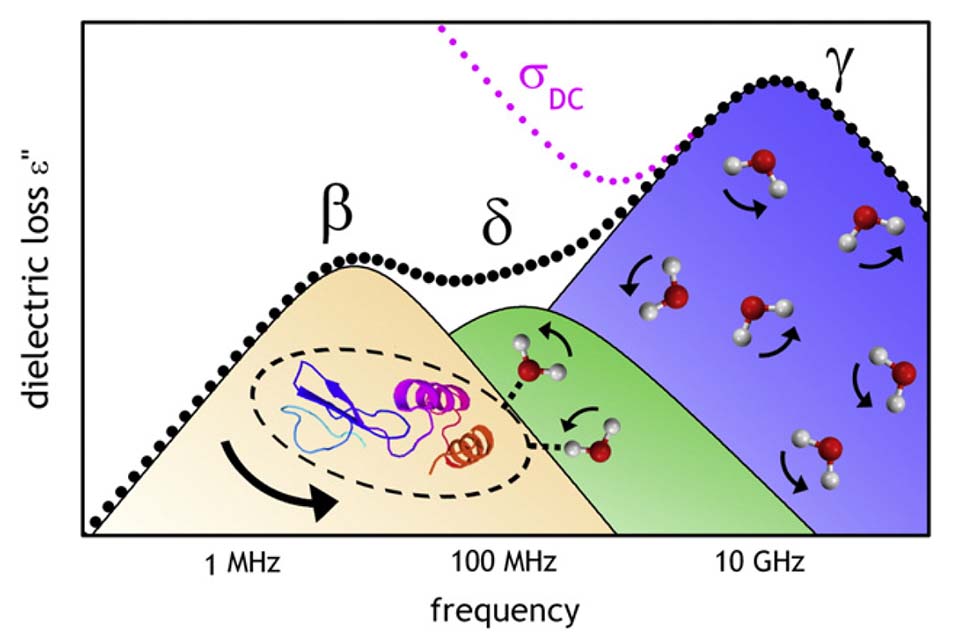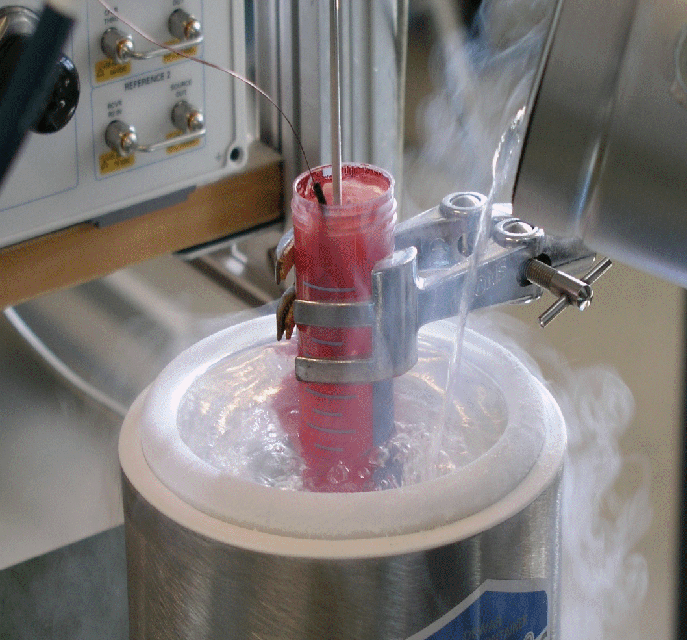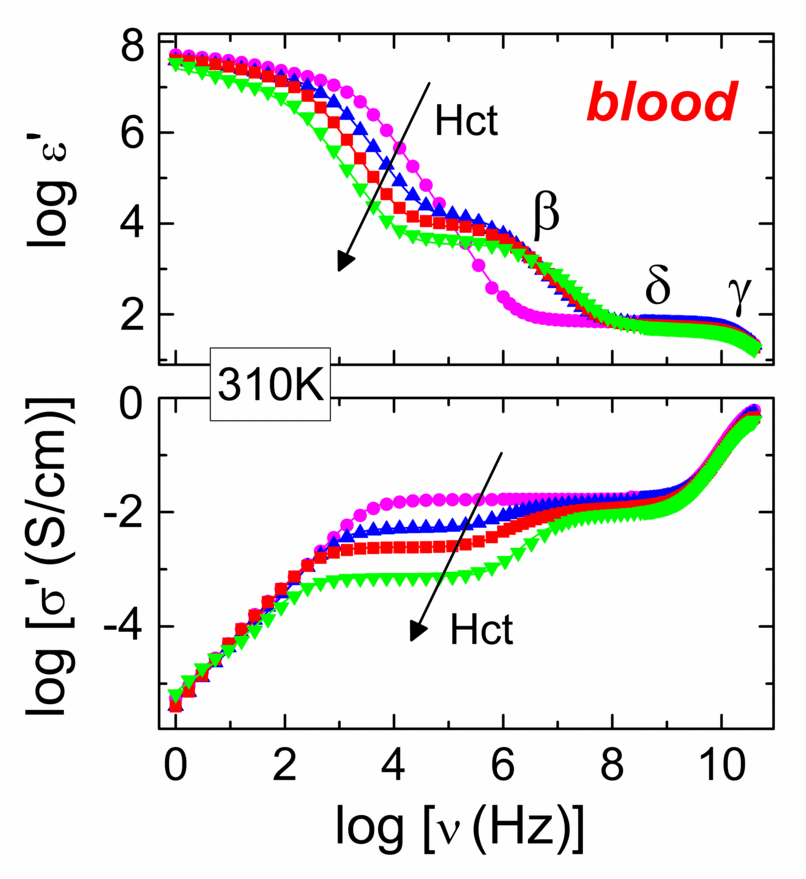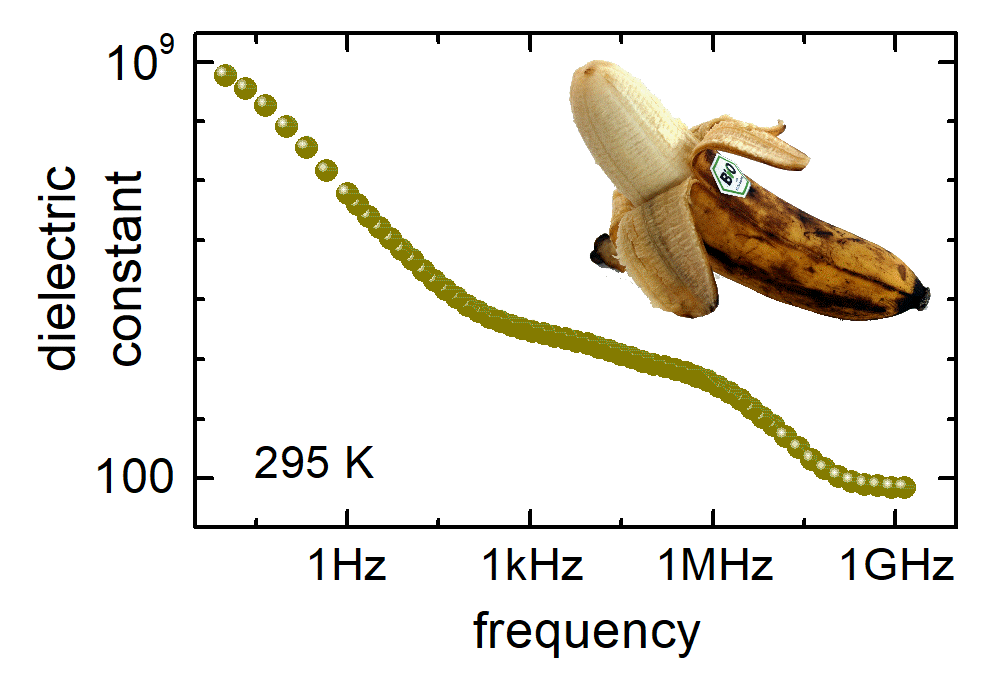BIOLOGICAL MATTER
Introduction
By dielectric spectroscopy, we investigate the dynamic processes in
biological materials like proteins that often have considerable impact
on biological functions in organisms. In addition, we have characterized the dielectric
properties of human blood which are highly relevant to understand its
interactions with electromagnetic waves. Another (quite funny) example is the measurement
of a banana, demonstrating the occurrence of non-intrinsic dielectric effects.
1. Proteins
Proteins are crucial to almost every biological process. With dielectric
spectroscopy, proteins can be examined not only in the solid state (i.e.
as powder), but also under nearly in vivo conditions (dissolved in water).
This is important, because
water
is essential for the biological
functions of proteins and, hence, the investigation of the interaction of
water with proteins is a very active field of research. As we are capable
of determining the dielectric properties in a
very broad frequency range,
we are able to investigate many different aspects of protein dynamic, e.g.,
relaxation processes (see the schematic figure) and the
"glass transition"
of proteins. We also shed light on the water-protein
interaction to evaluate the role of water for the protein dynamics and
functionality.

|
Schematic view of the typical loss spectrum of a protein solution.
The β and γ relaxations arise from the tumbling motions of the protein
and the water molecules, respectively. The origin of the δ relaxation, here
indicated to arise from bound water molecules within the protein hydration shell, is
still controversially discussed.
[from: M. Wolf, R. Gulich, P. Lunkenheimer, and A. Loidl,
Relaxation dynamics of a protein solution investigated by dielectric spectroscopy,
Biochim. Biophys. Acta. 1824, 723 (2012).]
|
Relevant publications from our
group in this field are:
- Kinetics of conformational sampling in ubiquitin
D. Ban, M. Funk, R. Gulich, D. Egger, T.M. Sabo, K.F.A. Walter, R.B. Fenwick, K. Giller, F. Pichierri,
B.L. de Groot, O.F. Lange, H. Grubmüller, X. Salvatella, M. Wolf, A. Loidl, R. Kree, S. Becker,
N.-A. Lakomek, D. Lee, P. Lunkenheimer, and Ch. Griesinger,
Angew. Chem. Int. Ed. 50, 11437 (2011). |
- Relaxation dynamics of a protein solution investigated by dielectric spectroscopy
M. Wolf, R. Gulich, P. Lunkenheimer, and A. Loidl,
Biochim. Biophys. Acta.
1824, 723 (2012). |
- Dynamics of protein hydration water
M. Wolf, S. Emmert, R. Gulich, P. Lunkenheimer, and A. Loidl,
Phys. Rev. E 92, 032727 (2015).
[PDF]
|
2. Blood
Blood is a highly functional body fluid. Its
dielectric parameters are of relevance for various medical applications
like cell separation,
checking the deterioration of preserved blood, and dielectric
coagulometry. In addition, the precise knowledge of the dielectric
properties of blood is prerequisite for fixing limiting values for
electromagnetic pollution, e.g., by mobile phones. For example, the ac conductivity directly affects the specific
absorption rate (SAR), for which upper limits are set by law.
In our group, we have investigated the dielectric constant, loss and
conductivity of blood as function of
frequency, temperature and hematocrit value (Hct: volume fraction of red
blood cells). Our measurements cover an exceptionally
broad frequency range
from 1 Hz to 40 GHz. Our measurements provide dielectric data on human blood of so far
unsurpassed precision for a broad parameter range. All data are available
in electronic form (see links below) to serve as basis for the
calculation of the absorption rate of electromagnetic radiation and
other medical purposes.

|
Dielectric measurement of blood with the open-end coaxial reflection method at 50 MHz - 40 GHz.
|
The obtained broadband dielectric spectra of blood show three major
dispersions, termed β, γ and δ (see figure below). The β process,
located around 10 MHz, is due to a
Maxwell-Wagner relaxation
caused by the inhomogeneities introduced by
the presence of the red blood cells. Around 18 GHz, the γ relaxation
arises from the tumbling of the dipolar
water
molecules in the
blood sample. Between the β and γ relaxations, significant "δ" dispersion is
observed, which, however, can be explained by a superposition of β and γ
and is not due to an additional microscopic process
often found in biological matter. The huge dispersion effect observed at
the lowest frequencies (< 10kHz) is due to non-intrinsic
electrode polarization.
We find no evidence for a low-frequency α relaxation as reported for some types of biological
matter.

|
Dielectric constant and real part of the conductivity of
blood samples with different hematocrit values as function of frequency,
measured at body temperature (310 K). The lines are fits assuming
different models to account for the electrode-polarization effect and
the β and γ relaxations.
[from: M. Wolf, R. Gulich, P. Lunkenheimer, and A. Loidl,
Broadband dielectric spectroscopy on human blood,
Biochim. Biophys. Acta. 1810, 727 (2011).]
|
Download of data:
(If you use them, please cite the paper listed below.)
For further details, see:
3. Banana
We used
dielectric measurements
of a banana to illustrate the occurrence of
colossal dielectric constants
and of P(E) hysteresis loops (like in a
ferroelectric)
due to purely non-intrinsic effects. It is shown, how the non-intrinsic nature of such effects
can be easily identified by performing a variety of simple experiments.

|
Broadband dielectric spectrum of the dielectric constant of banana skin at room
temperature. Colossal values of the dielectric constant (up to 109!)
and several relaxation modes show up. Essentially, they arise from the ionic
conductivity of the banana and are due to nonintrinsic effects like Maxwell-Wagner
relaxations.
[from: A. Loidl, S. Krohns, J. Hemberger, and P. Lunkenheimer,
Bananas go paraelectric,
J. Phys.: Condens. Matter 20, 191001 (2008).]
|
For further details, see:
Homepage P. Lunkenheimer



